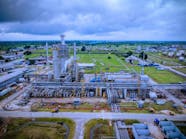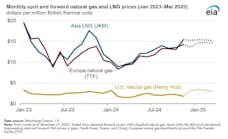The refinery also has completed an overall $650 million upgrade that includes a new visbreaker and vacuum column. Petrogal says the project has increased gasoline production to about 30,000 b/d.
THE EXPANSION
The refinery expansion project was performed by Petrogal, ABB Lummus Crest Inc., and Badger Co. The project began in February 1992 and was completed in June 1994, 1 month ahead of schedule.
Major units constructed for the overall refinery expansion included:
- A 35,000 b/sd FCCU
- A 26,000 b/sd visbreaker
- A 45,000 b/sd vacuum distillation unit
- Two extractive mercaptan columns
- An amylene treater
- A sulfur-recovery system
- An 8,000 b/sd alkylation complex.
The project also included the construction of utilities, a cooling tower, an additional flare, effluent treatment facilities, associated piping, and power and instrument cables.
Construction of the gasoline complex began in March 1993 and was completed in 1 year. As a result of the fuels project, production of gasoline and jet fuel has increased by almost 70,000 b/d, or 45%.
The additional gasoline will be used to meet growing demand in Portugal and the rest of Europe. "This complex means we can now compete globally," said Carlos Pombo Rodrigues, director general of the Sines refinery expansion project. "We may even be selling gasoline in the United States soon."
Rodrigues says the refinery formerly converted 24% of its 200,000 b/d crude throughput to gasoline and jet fuel. "We now process 35% of the same crude feedstocks into these valuable products," he added.
The production of heavier, less-valuable products has decreased from 52% before the project, to 34% of the refinery's current product mix.
GASOLINE COMPLEX
Petrogal selected Phillips Petroleum Co.'s HF alkylation and Hydrisom processes for the alkylation portion of the complex.
Rodrigues says Petrogal chose the Phillips process over sulfuric acid alkylation because the refinery had no on-site sulfuric acid regeneration capabilities.
He said, "We would have had to ship sulfuric acid from Ghent, Belgium, to our port facilities here, then transport five 20-ton trucks to the refinery each day. This would require our company to build new harbor facilities, new roads, and purchase a fleet of trucks just for sulfuric acid transport."
He added, "Beyond this enormous commercial penalty, we would also be faced with the possibility of safety risks to the community by moving that much acid daily."
The new Hydrisom unit selectively hydrogenates butadiene from the FCCU and isomerizes butene-1 to butene-2. This enables Petrogal to achieve a high isobutane-to-olefin ratio of 13-to-1, according to Phillips' technology licensing manager, Larry Shoemaker. Selectively hydrogenating butadiene in the olefin feedstock before it reaches the HF reactor also reduces production of acid-soluble oils (ASO) and increases alkylate yield.
Also included in the gasoline complex are:
- A defluorinator, to remove fluorides from butane and propane
- An HF stripper
- A depropanizer
- An FCCU
- A feedstock heater, which uses refinery fuel gas and ASO for fuel.
Petrogal also built a new highway between the Sines port and the refinery, 24 km (15 miles) away, to transport the 90-m tall crane and the alkylation unit's fractionation tower, which was built in Spain.
When the fractionator arrived in late October 1993, the 450-ton, 82-m tower was moved to the refinery on flatbed transport.
The tower was erected, and pipe fittings and electrical connections were completed. Hydrotesting had begun by the end of November, and 354 hydrotests were performed over the following 4 months.
The complex was ready for initial operation by Apr. 7,1994.
LABORATORY
Laboratory technicians test alkylate quality twice per day at a laboratory built within the alkylation complex.
Operators use the test results to make any necessary changes in processing parameters.
In addition to alkylate testing, the gasoline-complex laboratory tests HF quality and analyzes unit intake and discharge, water purity, and ASO concentration and composition.
SAFETY
The Phillips design incorporates a number of safety features, including reduced use of acid pumps, shaft seals, and gasketed connections in the reactor circuit, and the elimination of reactor stirrers.
The unit also incorporates elevated acid coolers and an acid storage tank that sits lower than any of the other HF-containing vessels. This back-up storage tank is large enough to hold all of the HF and hydrocarbons in the operating system. The tank is part of Phillips' rapid acid-transfer and vapor-mitigation systems.
This design uses remote-control valves and the weight of the HF itself to control potential acid releases by completely emptying the main reactor
within 10 min. This fast response minimizes the amount of acid that can leak from the system.
The unit also incorporates high-capacity water deluge equipment to control any escaped HF vapors.
Critical equipment is fitted with water spray nozzles, and all process pumps are equipped with fire detectors and water spray equipment.
The safety scheme also includes water cannons, which are operated manually so that they can be aimed precisely.
Early in the project, a team of engineers from Petrogal, Phillips, Badger, and ABB Lummus Crest performed a series of thorough hazard and operations reviews. These reviews resulted in a number of engineering changes which were incorporated into the detail design of the process unit.
"Concrete barriers surround the HF alkylation unit to contain any released HF scrubbed from the atmosphere by water deluge equipment," said HF unit project engineer Manuel Leao Tavares. "Effluent would be directed to special drain sumps and then to concrete containment ponds to prevent leaching into the ground or entering surface water."
These holding ponds are unique to Petrogal's design, according to Phillips.
The basins were built to specially treat any runoff water from the unit. The basins are designed to contain, control, and neutralize materials. The largest is capable of handling 2,000 cu m of water.
Any effluent entering the first basin is agitated with caustic soda. In the second basin, calcium fluoride is removed from the neutralized spent caustic. The third basin is used for effluent storage.
CONTROL ROOM
Petrogal operators control the unit from a sophisticated, computerized control room in a building located 1 mile from the gasoline complex. Early warning leak detection is provided by sensors on key valves and by hydrocarbon and acid detectors.
Closed-circuit television throughout the complex compliments the distributed control system.
Four cameras are used to monitor the major pieces of equipment in the complex. This system allows the refinery to reduce the number of nonessential personnel in the HF unit area.
A specially trained maintenance and quality-control group is stationed at the unit around the clock.
START-UP
Meireles de Barros, project manager for start-up of the gasoline complex, said, "It took us less than 20 hr to load the 70 cu m HF acid storage tank with hydrofluoric acid for the first time. We transferred the acid catalyst from tanker trucks into the Phillips unit simply by pressurizing the unit with nitrogen, then pumping nitrogen into the tanker trucks, pushing the hydrofluoric acid into the storage tank safely and with minimal atmospheric vapors."
After start-up on July 1, the unit produced alkylate within a few hours. According to de Barros, at start-up the unit produced alkylate with 97.8 RON and 95 MON.
The HF unit is now producing 10,000 b/sd of alkylate-some 25% over design capacity.
Copyright 1995 Oil & Gas Journal. All Rights Reserved.


